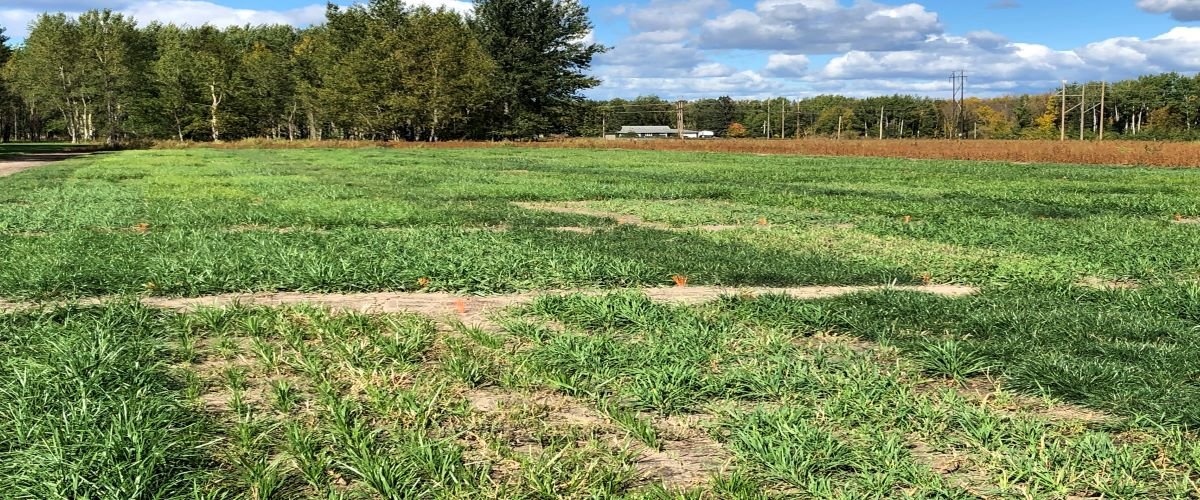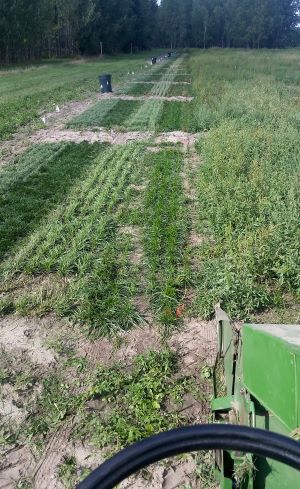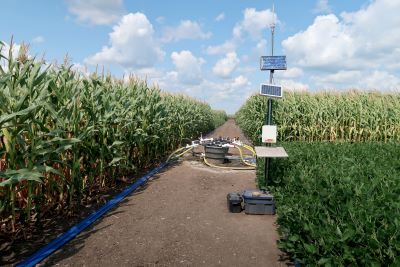
What’s in a drought? Research challenges and opportunities

The 2021 growing season has been one to be remembered across Minnesota. Most of the state started the year with abnormally dry conditions that escalated to exceptional and extreme drought (the U.S. drought monitor’s worst drought categories) in counties across the state by mid summer.
Negative effects of these drought conditions, like stunted crop development and a lack of water running through drainage ditches, are easy to see in fields throughout the state. At CFANS’ Research and Outreach Centers across the state, the drought’s impact is more varied — presenting both research challenges and opportunities.
Stifling pasture productivity
Drought conditions reduced pasture and forage production significantly at beef cattle and dairy research sites.
For Brad Heins, CFANS associate professor at the West Central Research and Outreach Center (WCROC) in Morris, conducting research on grazing conventional and organic dairy herds in such a hot and dry year has been a challenge.
“We’ve only been grazing our herd for half days,” Heins explains. “Cows were in the barn during the day and only grazed at night.” This shortened grazing schedule means less data is collected for a precision technology grazing project that needs cows on pasture for 24 hours to capture the sought-after data.
Heins also intended to start studying increasing legumes in pasture diets this year. He planted new research plots in pastures in May, but it didn’t rain for 14 days following planting. “I didn’t get any growth in those plots; it has set me back a full year. I’ll replant the plots this fall and hopefully get them established next year.”
At the North Central Research and Outreach Center (NCROC) in Grand Rapids, the drought conditions cut forage production by a third but actually aided a perennial grass research trial initiated this past spring.
“We didn't expect drought tolerance to be something we’d look at in this new perennial grass trial trial — we were interested in winter hardiness for our northern climate,” said Dan Braaten, NCROC operations manager and agronomist. “The drought gave us a bonus opportunity to look at both drought tolerance and winter hardiness.”
In a trial that includes over 40 different varieties of grasses, the drought tolerant varieties quickly emerged. “We had several varieties that didn’t germinate or were much slower to get established versus others that did quite well. This data combined with the winter hardiness data we plan to collect should provide landowners in the region valuable information on what varieties will thrive in their pastures and conservation areas,” said Braaten.
Looking at water in new ways
Lindsay Pease, assistant professor in the Department of Soil, Water and Climate, Extension nutrient and water management specialist, and Agricultural Research, Education, Extension and Technology Transfer (AGREETT) faculty member, has a large drainage study in place at the Northwest Research and Outreach Center (NWROC) in Crookston. As of the end of August, the NWROC had recorded only 6.18 inches of precipitation in 2021, making it the driest January to August period on record since the center began collecting weather data in 1890.
It’s hard to study drainage in a year with such little rain.
“We’ve had to shift how we’re thinking about looking at water in the plot,” Pease explains. “We’re focusing a lot more on soil moisture and getting a picture of how that’s looking in the root zone, especially in northwest Minnesota’s heavy clay soils.”
With the frequency of extremely wet and extremely dry years anticipated to increase as Minnesota’s climate changes, Pease sees supplemental water management strategies like irrigation and drainage, or a combination of the two, becoming increasingly important to getting a stable crop every year.
“I’m hoping to integrate irrigation into my research along with the drainage research to look at a systems approach. Controlled drainage with lift stations could be a good strategy for both wet years and times of drought to help hold water in the soil profile,” Pease notes. “However, these are expensive practices for farmers to implement so they need to know if such large investments will pay off over time.”
The University's primary irrigation research site, the Sand Plains Research Farm in Becker, ran its irrigation equipment seven days a week from June to August and pumped 44 percent more water in 2021 than typical years to keep up with crop demand. All that extra pumping requires more labor and electricity to keep things running and raises concerns about groundwater supply, water quality, and other environmental impacts.
At the Southwest Research and Outreach Center (SWROC) near Lamberton, Jeff Strock, professor in the Department of Soil, Water and Climate, took advantage of the dry year to study a nontraditional irrigation strategy that can mitigate some of the water quality concerns that come with irrigation.
Strock is experimenting with drainage water recycling, a practice that uses drainage water held in a pond at the edge of a field to irrigate crops. Plots in the study are under three treatments — rainfed, full irrigation, and limited irrigation.
As expected, there have been striking visual differences between the plots. “We’ve seen really big differences in the performance of the crop in terms of water use and crop growth,” explains Strock, who studies drainage water quality and nutrient management. “It’s easy to see which plots are irrigated and which are rainfed. The irrigated corn is taller and the soybean plants are bigger and fuller.”
The yield differences among these plots will be determined at harvest, but Strock has already found valuable information on how the crops respond to both heat and dry stress.
“The resilience and recovery of plants has been exceptionally interesting to look at. We’ve been measuring leaf canopy temperature during the heat of the day as well as at night. Where we have no irrigation, plants go into stress earlier and quicker than irrigated plants and then stay in a stressed state longer. It’s providing unique data to help us understand how plants respond to these drought conditions," he said.
Watch this video to see how SWROC research is taking a holistic approach to managing agricultural drainage water to help enhance crop yields while limiting environmental impacts.
Pest pressure points
A silver lining of the hot and dry conditions was that it suppressed many crop diseases that typically thrive in cool and/or humid conditions. While lower disease instances are generally a good thing for growers, it can mean different things for research progress.
For Charlie Rohwer, a horticulture researcher at the Southern Research and Outreach Center (SROC) in Waseca, the lack of rain and reliance on drip and sprinkler irrigation made disease control easier for most of his horticultural research projects, but it interfered significantly with a broccoli study.
“We purposefully inoculated broccoli plants with black rot in order to determine which varieties were more susceptible to the disease,” Rohwer explains. “Black rot spreads by splashing water, generally in the form of rain. Our sprinkler has been insufficient to cause extensive spread of the disease so we’re not getting the data we had hoped for.”
The lack of fungal diseases and dry conditions resulted in increased insect pressure in several crops in Minnesota. Ian MacRae, professor in the Department of Entomology and Extension entomologist at the NWROC, says the hot weather sped up insects’ physiological processes and led to high populations of pests that typically aren’t as much of a concern.
“We didn’t get natural control from fungal diseases this year so we saw high numbers of aphids in small grains, spider mites in soybeans, and grasshopper issues throughout the state,“ MacRae explains.
MacRae responded to the high insect populations by turning some of his research plots into residual activity trials. “The insects definitely affected the type of data we collected and how we’re looking at it,” he said. “We looked at how long the insecticide treatments can last — it’s a worst case scenario kind of thing.”







